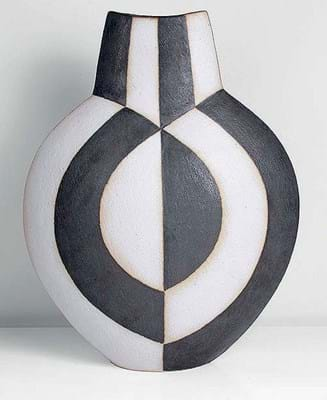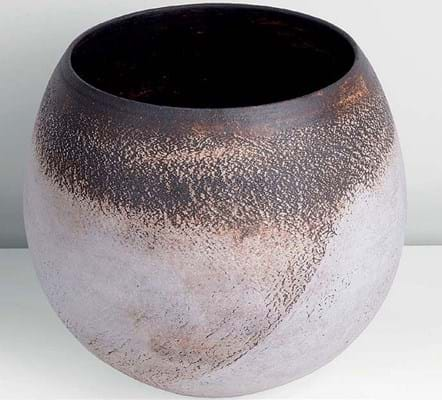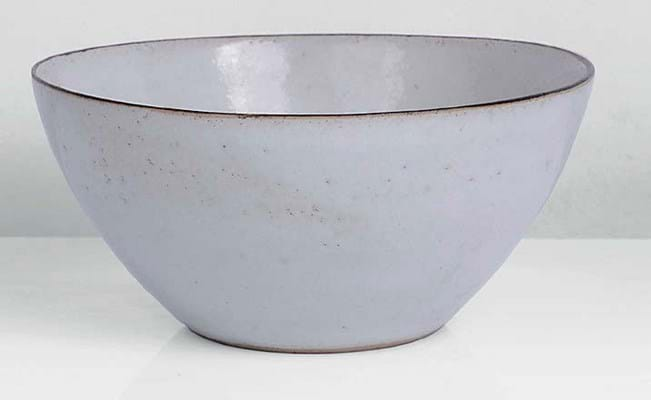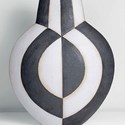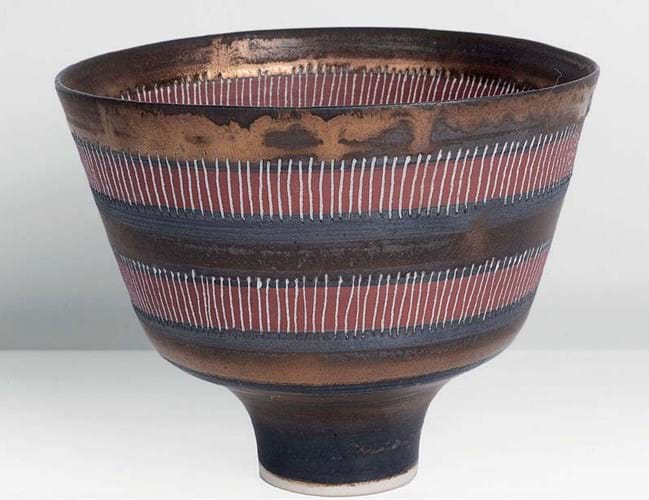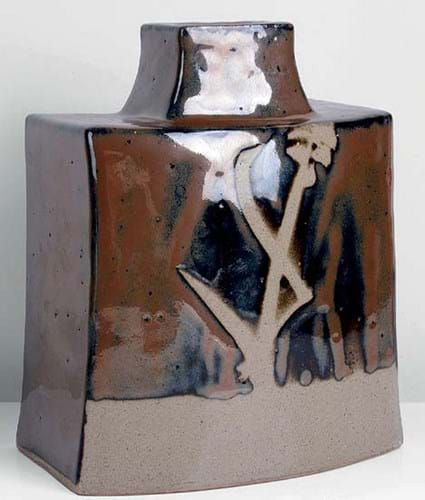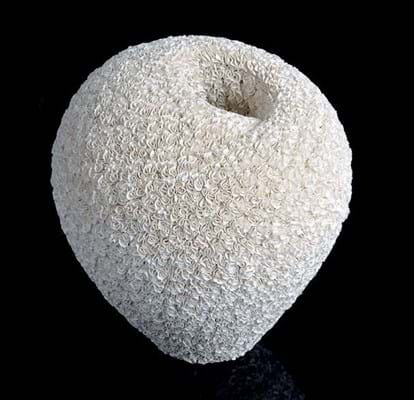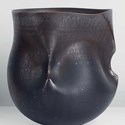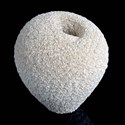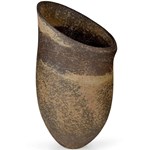Evidence of its international pull came at the biannual sale at Maak (20% buyer’s premium), which included a consignment of 77 lots from a collector in Miami. Registered bidders came from 71 countries.
The leading lots at the November 14 sale in London’s Royal Opera Arcade were by Dame Lucie Rie (1909-95) and her one-time apprentice and fellow refugee from Nazi Europe, Hans Coper (1920-81).
Provenanced to another impeccable source – the Coper family collection – Coper’s c.1969, 10in (25cm) diameter globular bowl led the day. It was in perfect condition and, against a £15,000-20,000 estimate, sold to an international private buyer at £64,000, the highest price for a Coper piece this year.
From the Miami consignment came one of Coper’s Squeezed Vessels, an 8in (20cm) tall, 1960 piece with four squeezed indents, porcelain slip and incised designs to the exterior and, to the interior, a manganese glaze and flower holder.
Also in perfect condition, it almost doubled the top estimate in selling at £38,000.
Two Rie porcelain pieces from Miami went comfortably above estimates. Her 4½in (11.5cm) tall, 1970 straight-sided bowl with golden manganese glaze, decorated with terracotta bands and sgraffito lines, went to a London collector at £26,000 and her c.1978, 8¼in (21cm) tall, flared-lip vase with a vivid blue glaze and sgraffito design took £22,000.
With supply still relatively plentiful, minor pieces by major names can be bought by the many lower-budget enthusiasts.
Here, for instance, Rie’s 1958 stoneware bowl, 1¾in (4.5cm) tall with shiny white glaze and manganese band was pitched at £400-500. With only a tiny restored chip rim, it sold to a Devon collector at £900.
“It is so brilliant that studio ceramics are accessible to collectors with a lower price range,” said Marijke Varrall-Jones of Maak, who set up on her own in 2009 when Bonhams closed the Contemporary ceramics department which she had headed.
Leach lots
The so-called ‘father’ of British studio pottery, Bernard Leach (1887- 1979), was well represented at the sale as was his fourth wife Janet (1918-97) and his son David (1911-2005). All made stoneware pieces.
Bernard’s 1960 rectangular bottle, 14½in (37cm) tall and layered with rich tenmoku over iron glazes – another from the wide-ranging Miami consignment – had some old epoxy filling and shallow firing cracks but went to a London collector above estimate at £1400.
Janet’s 8¼in (21cm) tall back bottle vase with white splashes and white gazes flare rim took £950 and David’s 14½in wide (36cm) bowl, featuring running white dolomite over tenmoku glazes with a wax resist Willow Tree design, made £1000.
Bernard’s friend Hamada Shoji (1894-1978), who accompanied him back to Britain after his Japanese sojourn to set up their first English pottery, was represented by 13 lots. The best of these was a 10in (25cm) stoneware curved bottle with persimmon-over-cream glaze and wax resist leaf motifs front and back. Offered in a signed wooden box, it went just above estimate to a UK collector at £3600.
Leach’s first apprentice, Michael Cardew (1901-83), went on to live a full and varied life after setting up on his own in 1926. Among his material at Maak was a piece from the two decades he spent in west Africa.
His stoneware Gwari casserole, a 12in (31cm) deep, red, brown and green glazed stoneware piece with two looping handles, was impressed MC and featured Ajuba Pottery seals. In perfect condition, it went a shade above hopes at £950.
European influence
Influenced by European refugees such as Rie and Coper, studio pottery began to move away from the classical Japanese influence so dominant in the early years.
In the next wave came the art school students of the late 1950s and the ’60s – the likes of John Ward (b.1938). Ward’s reputation has grown considerably in the last couple of decades but at least some of the heat has gone out of the market. Most of the dozen offerings at Maak could be had for low-to-mid four figures and one, a 5½in (14cm) tall stoneware Squared Pot, 1990, went at £950.
Best of the Wards was his 1999 Monumental Vessel, a 12½in (32cm) tall stoneware work. Featuring his distinctive and much in-demand black and white bands, it came from Miami in perfect condition and doubled the mid-estimate, selling to a London collector at £11,000.
Consigned from a different US vendor was a stoneware abstract by Ursula Morely-Price (b.1936).
Titled Dark Ruffel, 1982 the 5in tall x 20in deep (13 x 20cm) piece had a pinched ruffle rim and broad undulations with a mottled green and dark grey glaze.
Pitched at £500-700, it sold to a Belgian private buyer at £3200.
Mary Rogers (b.1929) is another British veteran ceramicist getting overdue recognition. In May, Maak took a record bid of £4800 for her small c.1985 Folded Bowl.
At the November sale a 1970 shallow porcelain Folded Bowl trademark piece, a 2½in (6.5cm) diameter pinched bowl squeezed to an oval, went as expected at £550 but a larger, 4¼in (11cm) tall example from 1978, with an undulating form raised on a small foot, took a fivetimes-estimate £3600.
Young guns
Some of the younger ceramicists are enjoying more immediate commercial success.
Makiko Hattori (b.1984) is one of a number of Japanese artists (many of whom have studied and worked in London) renewing the links of their country to the British scene.
The £2000-3000 estimate on her c.2017 textured porcelain vessel illustrated her current standing. A rounded form, 6½in (16.5cm) diameter, it featured an inverted folded rim and was applied with ribbons of unglazed porcelain. In perfect condition, it sold to a London collector at £4000.
Irish ceramicist Sara Flynn (b.1971) became known to the wider studio collecting world when she was a finalist for the influential Loewe Craft Prize two years ago.
Like that of most of her fellow potters, her work can be both relatively affordable and more highly priced.
At Maak, her c.2010 porcelain Small Line Vessel – a 4½in (11.5cm) diameter rounded form piece with a lustrous speckled manganese glaze and an impressed line to one side – went on the lower £600 estimate.
However, more was required for the 2012 porcelain Double Hipped Vessel. Provenanced to the Dayabandhu (Michael Evans) collection, the 6¼in (16cm) tall piece was estimated at £1000-1500 but sold to a Londonbased collector at £9000.
Dingley auction
Maak’s sale was held ahead of the Peter Dingley (1923-2018) auction at Mallams Oxford on December 5.
Dingley’s gallery in Stratfordupon-Avon, which ran from 1966-91 (first in Meer Street, then Chapel Street) became synonymous with studio ceramics. His collection will be sold in 55 lots to benefit two charities for living potters.
Also see the Lyon & Turnbull report this edition.


